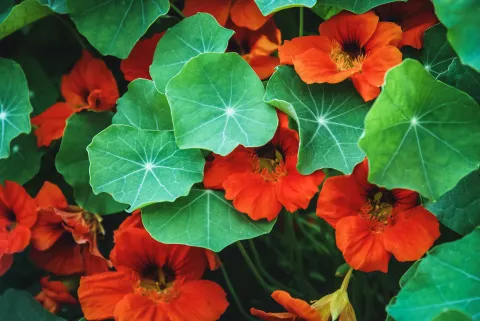
Scientific Name
Tropaeolum majus
General Information
Nasturtiums are cool season annual that bloom spring through fall. Their peppery flower, leaf and seed are edible and a trailing branch makes a lovely addition to a flower arrangement. They can also be trained to climb up an arbor or fence.
When to Plant
Seeds: Sow seed in early spring about 8 to 12 inches apart.
Transplants: Seedlings growing in the ground do not transplant well but nursery starts do well. Plant in spring.
Cuttings: You can grow nasturtiums from cuttings. Cut 4-inch piece of stem just below a leaf node. Roots well in water.
Layering: Where trailing nasturtiums find the ground, they root well. Learn more about layering.
Planting
Plant in full sun in cooler settings.
Soil Requirements
Nasturtiums do well in average, well-drained soils.
Water Requirements
Prefers moderate, consistent water. However, blooms will actually increase if the plant gets less water.
Fertilizing
Avoid fertilizer, is it can result in more leaves and fewer flowers.
Pollination
Bees, hummingbirds, butterflies
Harvesting
Harvest leaves like lettuce. Green seeds can be harvested and pickled to be used like capers.
Storage
Store leaves in refrigerator like lettuce leaves. Put flower stems in water until just before using.
Good Varieties for Marin
'Alaska’ has variegated leaves and bright orange flowers, ‘Amazon Jewel’ is a great climber with firecracker blooms. ‘Peach Melba” has creamy yellow and orange blooms and ‘Empress of India’ has brilliant orange-red blossoms and blue green foliage. To add to herb borders, there are dwarf varieties which grow to around one foot tall.
Helpful Tips
Nasturtiums reseed easily but are not difficult to pull out if unwanted.
Common Problems
Nasturtiums do not tolerate heat well.
Nasturtiums are host plants for certain butterflies. When the eggs hatch, caterpillars will eat the nasturtium leaves. Nasturtiums also attract aphids.

